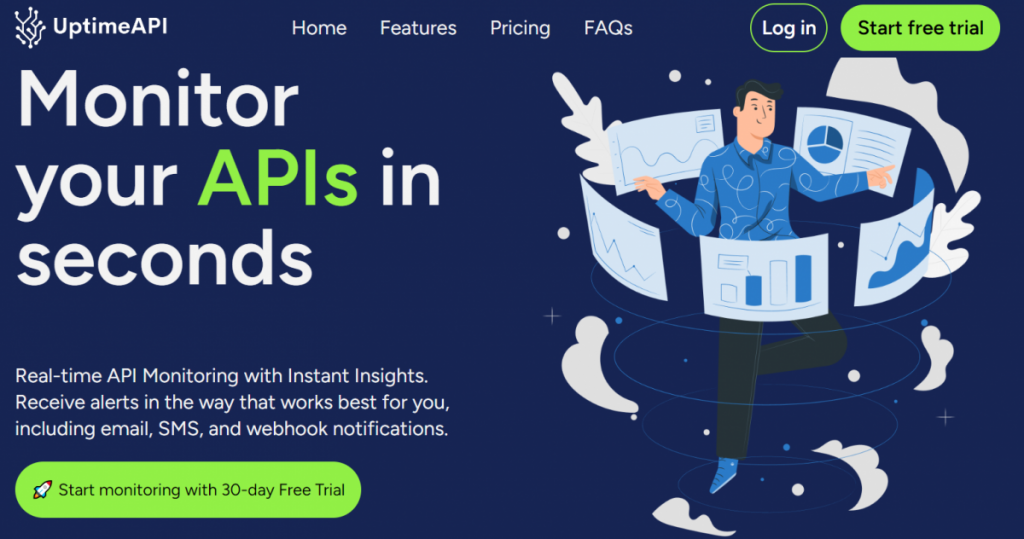In the fast-paced world of software development, where the reliability and performance of APIs are mission-critical, having the right tools for monitoring and optimization is essential. UptimeAPI emerges as a powerful solution for developers looking to streamline their API usage. This quick guide aims to provide developers with a concise yet comprehensive overview of UptimeAPI and its features, along with insights into the API responses that can empower developers to enhance their API usage.
Understanding the Significance of API Usage

1. Why API Usage Matters
APIs are the backbone of modern applications, facilitating seamless communication between different software components. Monitoring and optimizing API usage are crucial for ensuring that applications function smoothly, providing users with a reliable and efficient experience.
2. Challenges in API Usage
As applications scale and become more complex, challenges such as potential downtime, slow response times, and error handling can arise. These challenges can impact user satisfaction and overall business success. Monitoring API usage becomes a proactive approach to addressing these issues.
Introducing UptimeAPI: A Quick Overview
1. Real-Time Monitoring
UptimeAPI offers real-time monitoring capabilities, allowing developers to track the performance of their APIs as it happens. Real-time insights enable quick identification and resolution of issues, minimizing downtime and optimizing user experience.
2. Customizable Dashboards
One of UptimeAPI’s standout features is its customizable dashboards. Developers can tailor their monitoring experience by selecting and displaying the metrics that matter most to their specific use case. This flexibility ensures a focused and personalized monitoring approach.
3. Historical Data Analysis
Understanding the historical performance of APIs is essential for making informed decisions. UptimeAPI stores historical data, enabling developers to conduct in-depth analysis and identify trends over time. This historical perspective is instrumental in optimizing APIs for long-term efficiency.
4. Multi-Channel Notifications
UptimeAPI understands the importance of immediate awareness during potential issues. The tool supports multi-channel notifications, sending alerts through channels like email, SMS, and integrations with popular communication platforms. This ensures that the right people are informed promptly, facilitating swift response and resolution.
Navigating UptimeAPI’s API Responses

Read More: Company profile APIUsage Cases
Understanding the API responses provided by UptimeAPI is crucial for developers looking to gain actionable insights into their API usage. Let’s break down what developers can expect from UptimeAPI’s API responses.
1. HTTP Status Codes
UptimeAPI communicates the outcome of API requests through standard HTTP status codes. A 200 status code typically indicates a successful request, while 4xx or 5xx codes signify errors. These status codes provide a quick and standardized way to assess the success or failure of API calls.
2. Response Time Metrics
Response time metrics are a key component of UptimeAPI’s API responses. These metrics provide information on how quickly an API endpoint responds to requests. Developers can analyze response times to identify potential bottlenecks and optimize performance.
3. Error Details
In the event of an error, UptimeAPI provides detailed error information in its API responses. This includes error codes, descriptions, and timestamps, facilitating rapid diagnosis and resolution of issues. The granular error details empower developers to pinpoint the root causes of problems.
4. Historical Performance Data
UptimeAPI goes beyond real-time monitoring by including historical performance data in its API responses. This data allows developers to analyze trends over time, identifying patterns, anomalies, and opportunities for optimization in their API usage.
Quick Steps to Enhance API Usage with UptimeAPI
1. Sign Up for UptimeAPI
To begin optimizing API usage with UptimeAPI, developers can sign up for an account on the UptimeAPI platform. The registration process is straightforward, providing access to the powerful monitoring tools.
2. Configure API Endpoints
Once logged in, developers can configure UptimeAPI to monitor their specific API endpoints. This involves adding the relevant details, such as the API URL, protocols (HTTP/HTTPS), and any necessary parameters.
3. Customize Monitoring Settings
UptimeAPI’s customizable monitoring settings allow developers to tailor their monitoring experience. Set up alert thresholds, choose the frequency of checks, and define the specific metrics to monitor, aligning the tool with the unique requirements of the API.
4. Integrate UptimeAPI into Development Workflow
Integration with UptimeAPI can be seamlessly incorporated into the development workflow. Developers can follow the integration guidelines provided by UptimeAPI, which include documentation and support to ensure a smooth and efficient integration process.
Conclusion: Elevate Your API Usage with UptimeAPI
API usage is a critical aspect of modern software development, and having the right tools can make all the difference. UptimeAPI, with its real-time monitoring, customizable dashboards, and insightful API responses, stands out as the go-to solution for developers seeking to optimize their API usage. By understanding the features and API responses provided by UptimeAPI and following the quick steps outlined in this guide, developers can take a proactive approach to monitoring and enhancing their APIs, ensuring a seamless and efficient user experience. Embrace UptimeAPI and elevate your API usage to new heights.

